Oracle Golden Gate 系列十五 -- GG Trails 說明
一.Trails 說明
理論知識在系列一里有說明,這裡在拿出來看一下:
To support thecontinuous extraction and replication of database changes, Oracle GoldenGatestores the captured changes temporarily on disk in a series of files called a trail.A trail can exist on the source or target system, or on an intermediary system,depending on how you configure Oracle GoldenGate. On the local system it isknown as an extract trail (or local trail). On a remote system it is known as aremote trail.
--為了支援連續的extraction 和 replication 資料的改變,GG抓取這些改變的資料臨時存放在一系列的磁碟檔案裡, 這些檔案就叫trail。 Trail 檔案可以放在Source或者Target system裡,甚至可以放到轉換的系統上,這主要取決與GG 的配置,如果存放在local system上,就叫extract trail 或者 localtrail,如果存放在remote system上就叫作remote trail。
By using a trailfor storage, Oracle GoldenGate supports data accuracy and fault tolerance. Theuse of a trail also allows extraction and replication activities to occurindependently of each other. With these processes separated, you have morechoices for how data is delivered. For example, instead of extracting and replicatingchanges continuously, you could extract changes continuously but store them inthe trail for replication to the target later, whenever the target applicationneeds them.
通過使用trail,GG 支援精確的資料同步和故障處理。
1.1 Processes that write to, and read, a trail
The primaryExtract process writes to a trail. Only one Extract process can write to atrail.
Extract 程序可以將capture data 寫入trail。只允許一個Extract程序寫入一個trail。
Processes that read the trail are:
以下2個程序可以讀取trail 檔案:
(1)Data-pump Extract: Extractsdata from a local trail for further processing, if needed, and transfers it tothe target system or to the next Oracle GoldenGate process downstream in theOracle GoldenGate configuration.
(2)Replicat: Reads a trail toapply change data to the target database.
Data pump 說明,可以參考:
1.2 Trail maintenance
Trail files arecreated as needed during processing, and they are aged automatically to allowprocessing to continue without interruption for file maintenance. By default,trails are stored in the dirdat sub-directory of the Oracle GoldenGatedirectory.
--Trail 檔案在程序執行時建立,trail 在使用時允許程序在不中斷的情況下進行維護。 預設情況下,trails存放在GG 安裝目錄的dirdat 子目錄下。
By default, eachfile in a trail is 10 MB in size. All file names in a trail begin with the sametwo characters, which you assign when you create the trail. As files arecreated, each name is appended with a unique, six-digit serial (sequence)number from 000000 through 999999, for example c:\ggs\dirdat\tr000001. When thetrail sequence number reaches 999999, the numbering starts over at 000000.
--預設情況下,每個trails 檔案為10MB,所有的trails由2個相同的字母開頭,當建立trail時,每個trail 檔名有我們指定的2個字母加6個數字組成,這樣來進行唯一性約束。 6個數字從000000 到999999. 當數字到達999999時,又繼續從000000開始。
You can createmore than one trail to separate the data from different objects or applications.You link the objects that are specified in a TABLE or SEQUENCE parameter to a trailthat is specified with an EXTTRAIL or RMTTRAIL parameter in the Extractparameter file.
--可以建立多個trail 檔案已分別存放不同物件的trail。
Aged trail filescan be purged by using the Manager parameter PURGEOLDEXTRACTS.
--使用中的trail 檔案可以使用Manager 引數:PURGEOLDEXTRACTS進行清空。
1.3 How processes write to a trail
To maximizethroughput, and to minimize I/O load on the system, extracted data is sent intoand out of a trail in large blocks. Transactional order is preserved. Bydefault, Oracle GoldenGate writes data to the trail in canonical format, aproprietary format which allows it to be exchanged rapidly and accurately amongheterogeneous databases. However, data can be written in other formats that arecompatible with different applications.
--為了最大的吞吐量和最小的系統I/O, trail 檔案的寫入和讀取都是按large block 進行。 預設情況下,GG 寫入trail 的檔案的內容都是特定的格式,特定的格式可以實現快速的exchange 和 不同資料庫之間實現精確的同步。當然也可以根據不同的應用,按照不同的格式進行寫入。
By default,Extract operates in append mode, where if there is a process failure, arecovery marker is written to the trail and Extract appends recovery data tothe file so that a history of all prior data is retained for recovery purposes.
預設情況下,Extract是append 模式,如果一個process 失敗,在下次啟動Extract 時,recovermarkder 可以寫入這個trail,進行Extract recovery操作,但是這個啟動Extract的過程會比較長。關於這個Extract recovery 的監控,在以下連結的1.1 小結有說明。
In append mode,the Extract initialization determines the identity of the last complete transactionthat was written to the trail at startup time. With that information, Extract endsrecovery when the commit record for that transaction is encountered in the datasource; then it begins new data capture with the next committed transactionthat qualifies for extraction and begins appending the new data to the trail. Adata pump or Replicat starts reading again from that recovery point.
--在append 模式下,在啟動Extract 初始化時,會在trail中找到last completetransaction的位置。然後從這個位置開始進行recovery,直到在data source裡遇到commitrecord,就結束Extract Recovery。Extract 正常啟動。 Extract 程序正常啟動之後,就可以正常的以append 方式寫入新的capturedata。
Data pump 程序或者Replicat 程序從Recover point 開始讀取data。
這個last complete transaction 可以理解為recover point,因為GG 也是根據歸檔和onlineredo 來的,所以這個recovery 過程也是從DB 的log裡進行判斷,找到了commit record,即GG和 DB 的log 一致,結束recovery 過程。
這段recovery 出來的tail data 還沒有傳送到target 上或者還沒有應用,所以Data pump 或 replicat 程序從這個recovery point 開始恢復。
在恢復階段,我們檢視Extract 程序的狀態,就顯示為APPEND。
這一段ExtractRecovery 過程是根據自己的理解來寫的,可能不完全正確,有其他理解的可以互相討論。
Overwrite modeis another version of Extract recovery that was used in versions of Oracle GoldenGateprior to version 10.0. In these versions, Extract overwrites the existing transactiondata in the trail after the last write-checkpoint position, instead ofappending the new data. The first transaction that is written is the first onethat qualifies for extraction after the last read checkpoint position in thedata source.
--Overwrite 模式的Extract Recovery 是GG 10.0版本之前使用的。 Extract 重寫trail中已經存在,並在lastwrite-checkpoint position之後的transaction data,代替了append new data。
If the versionof Oracle GoldenGate on the target is older than version 10, Extract will automaticallyrevert to overwrite mode to support backward compatibility. This behavior canbe controlled manually with the RECOVERYOPTIONS parameter.
--如果Target GG的版本小於10,ExtractGG的版本大於10,為了相容性, Extract 將自動轉換成overwrite 模式。 可以通過RECOVERYOPTIONS引數手工的控制這種自動轉換的功能。
1.4 Trail format
As of OracleGoldenGate version 10.0, each file of a trail contains a file header recordthat is stored at the beginning of the file. The file header containsinformation about the trail file itself. Previous versions of Oracle GoldenGatedo not contain this header.
在GG 10.0版本里,每個trailfile 包含一個file header,其用來儲存beginning of file。 10.0 版本之前的GG 不包含header。
Each data recordin a trail file also contains a header area, as well as a data area. The recordheader contains information about the transaction environment, and the dataarea contains the actual data values that were extracted.
每條trail file的record中包含一個headerarea和data area。 Record 的headerarea 包含transaction environment,data area 包含實際的的extracteddata。
Trail 的格式在第二部分具體進行說明。
二.Trails 中record format
我們可以通過GG 自帶的logdump 工具來檢視trails 檔案的具體格式。
2.1 logdump 工具使用說明
MOS 上有關logdump的2篇文件:
How To Save A Part Of A GoldenGate Trail ToA New Trail [ID 966188.1]
Oracle GoldenGate - Using the GoldenGateLogdump Utility to Manually Load Balance across Multiple Processes [ID1301300.1]
2.1.1 進入GG 安裝目錄,執行logdump命令。
cgg1:/home/oracle> cd /u01/ggate/
gg1:/u01/ggate> logdump
Oracle GoldenGate Log File Dump Utility
Version 11.1.1.1OGGCORE_11.1.1_PLATFORMS_110421.2040
Copyright (C) 1995, 2011, Oracle and/or itsaffiliates. All rights reserved.
Logdump 1 >
2.1.2 set up the view –建立logdump環境
(1)To view the record header with thedata:
Logdump 1 >ghdr on
(2)To add column information
Logdump 2 >detail on
-- Column informationincludes the number and length in hex and ASCII.
(3)To add hex and ASCII data values to the column information:
Logdump 3 >detail data
(4)To view user tokens:
Logdump 4 >usertoken on
(5)To control how much record data is displayed:
Logdump 5> RECLEN <length>
Logdump 5 >reclen 1000
Reclen set to 1000
2.1.3 To open a trail file 開啟檔案
(1)指定trail 檔案
Logdump 6 >open /u01/ggate/dirdat/lt000008
Current LogTrail is/u01/ggate/dirdat/lt000008
(2)To go to the first record and thenmove through records in sequence:
Logdump 7>NEXTor N
示例:
Logdump 7 >n
___________________________________________________________________
Hdr-Ind: E (x45)Partition : .(x04)
UndoFlag: . (x00)BeforeAfter: A (x41)
RecLength: 45 (x002d)IO Time : 2011/11/1713:11:28.000.000
IOType: 5 (x05)OrigNode : 255(xff)
TransInd: . (x00)FormatType : R (x52)
SyskeyLen: 0 (x00)Incomplete : . (x00)
AuditRBA: 23 AuditPos : 16783888
Continued: N (x00)RecCount : 1(x01)
2011/11/17 13:11:28.000.000 Insert Len 45 RBA 1009
Name: DAVE.BL
AfterImage:Partition 4 G b
00000006 0000 0002 424c 0001 0006 0000 0002 3839 | ........BL........89
00020015 0000 3230 3131 2d31 312d 3137 3a31 333a | ......2011-11-17:13:
30393a32 34| 09:24
Column0 (x0000), Len 6 (x0006)
00000002 424c| ....BL
Column1 (x0001), Len 6 (x0006)
00000002 3839| ....89
Column2 (x0002), Len 21 (x0015)
00003230 3131 2d31 312d 3137 3a31 333a 3039 3a32 | ..2011-11-17:13:09:2
34| 4
2.1.4 To go to a specific RBA in the file定位
(1)To go to an RBA anywhere in the file:
Logdump 9> POS <rba>
Logdump 10> N
示例:
GGSCI (gg1) 8> info ext1
EXTRACTEXT1 Last Started 2011-11-1910:02 Status RUNNING
Checkpoint Lag 11:49:46 (updated 00:00:06 ago)
Log Read Checkpoint Oracle Redo Logs
2011-11-18 22:12:21 Seqno 26, RBA 22834688
Logdump 10 >pos 22834688
Reading forward from RBA 22834688
Logdump 11 >n
--因為當前的extract使用的trail 檔案不是lt000008,所以這裡沒有顯示結果。
(2)To go to the first record in the file:
Logdump 11> POS FIRST
或
Logdump 11> POS 0
示例:
Logdump 12 >pos 0
Reading forward from RBA 0
Logdump 13 >n
2011/11/17 13:08:42.353.436 FileHeader Len942 RBA 0
Name: *FileHeader*
30000199 3000 0008 4747 0d0a 544c 0a0d 3100 0002 | 0...0...GG..TL..1...
00023200 0004 2000 0000 3300 0008 02f1 d81a ab92 | ..2... ...3.........
1f1c3400 0014 0012 7572 693a 6767 313a 3a75 3031 | ..4.....uri:gg1::u01
3a676761 7465 3600 001c 001a 2f75 3031 2f67 6761 | :ggate6...../u01/gga
74652f64 6972 6461 742f 6c74 3030 3030 3038 3700 | te/dirdat/lt0000087.
00010138 0000 0400 0000 0839 0000 0800 0000 0000 | ...8.......9........
001b493a 0000 8107 3133 3633 3532 3200 0000 0000 | ..I:....1363522.....
00000000 0000 0000 0000 0000 0000 0000 0000 0000 | ....................
00000000 0000 0000 0000 0000 0000 0000 0000 0000 | ....................
00000000 0000 0000 0000 0000 0000 0000 0000 0000 | ....................
2.1.5 To filter based on a table name
(1)To filter out everything exceptrecords containing a specific table name:
Logdump 14> FILTER INCLUDE/EXCLUDEFILENAME <schema>.<table>
Now, when you use the N command, you willonly see records that satisfy this filter.
(2)To remove the current filtercriteria
Logdump14> FILTER CLEAR
(3)To filter on multiple conditions
Logdump 14> FILTER INCLUDEFILENAME <schema>.<table>; FILTER RECTYPE <record_type>;FILTER MATCH ALL
2.1.6 To count the records in a trail file
Logdump 14> COUNT
示例:
Logdump 14 >count
LogTrail /u01/ggate/dirdat/lt000008 has 37records
Total Data Bytes 3834
AvgBytes/Record 103
Insert 34
RestartOK 1
DDL 1
Others 1
After Images 36
Average of 4 Transactions
Bytes/Trans ..... 1402
Records/Trans ... 9
Files/Trans ..... 1
Partition 0
Total Data Bytes 1153
AvgBytes/Record 576
RestartOK 1
DDL1
After Images 2
*FileHeader*Partition 0
Total Data Bytes 942
AvgBytes/Record 942
Others 1
DAVE.BL Partition 4
Total Data Bytes 1739
AvgBytes/Record 51
Insert 34
After Images 34
2.1.7 To save records to a new trail file
(1)To save the whole file:
Logdump 15> SAVE <file>
Where: <file> is the name of the newfile.
(2)To save a subset of records:
Logdump15> SAVE <file> <n>RECORDS
To close the current file and open the nextone in the trail
Logdump 15> NEXTTRAIL
2.1.8 To keep a log of your session
(1) To start logging:
Logdump 15> LOG TO <filename>.txt
(2)To write text to the log:
Logdump 15> WRITELOG “<text>”
(3)To stop logging:
Logdump 15> LOG STOP
2.1.9 To see the current Logdumpenvironment
Logdump 15> ENV
This shows whichfeatures are enabled, such as filtering and header views, and it showsenvironment information such as the current trail and position.
示例:
Logdump 15 >env
Version : Linux, x64, 64bit (optimized) onApr 21 2011 22:44:06
Current Directory : /u01/ggate
LogTrail : /u01/ggate/dirdat/lt000008
Trail Format : New
End of File : 6985
Current Position : 0Forward
Next Position : 0
Last Modtime : 2011/11/17 17:16:22.000.000
Display RecLen : 200
Logtrail Filter : On
Show Ghdr : On
Detail : Data
UserToken : On
Trans History : 0 Transactions, Records 100, Bytes100000
LargeBlock I/O : On, Blocksize 57344
Local System : LittleEndian
Logtrail Data : BigEndian/ASCII
Logtrail Headers : ASCII
Dump : ASCII
Savefile comments : Off
Timeoffset : LOCAL
Scan Notify Interval: 10000 records,Scrolling On
2.1.10 To get online command help
Logdump 17> HELP
2.1.11 To exit Logdump
Logdump 17> EXIT
或
Logdump 17> QUIT
2.2 Trails 格式說明
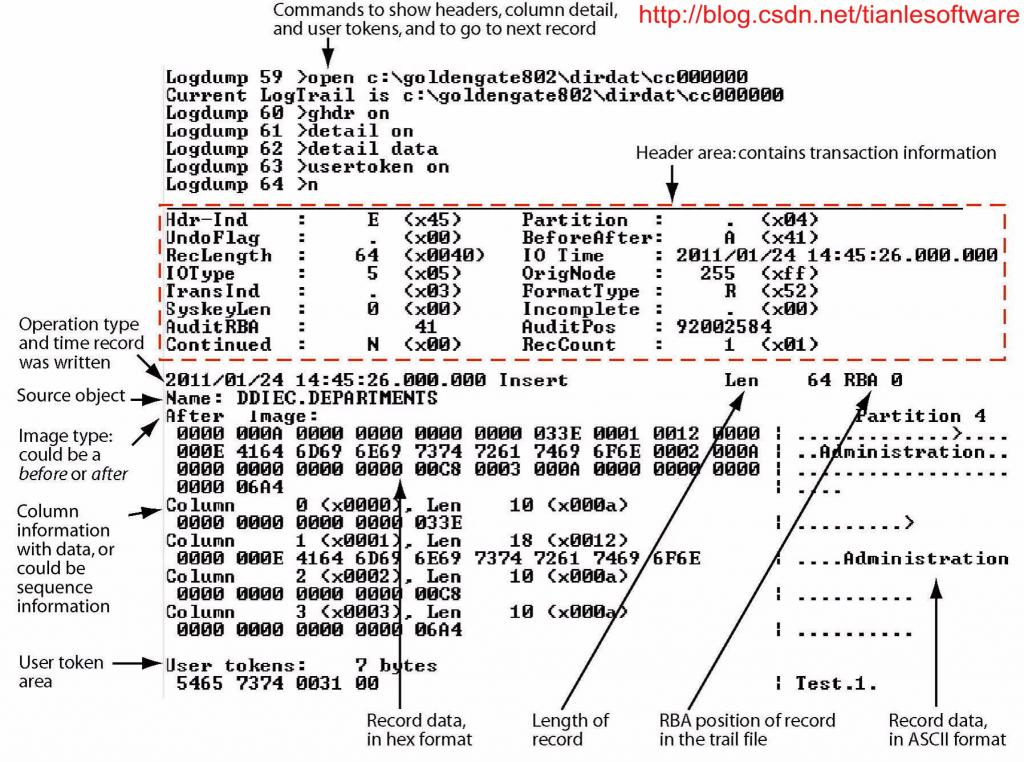
這個是官方文件上的一個圖。我們現在來看一下,
2.2.1 Record header area
The OracleGoldenGate record header provides metadata of the data that is contained in therecord and includes the following information.
--GG record header 包含以下內容:
(1)The operation type, such as aninsert, update, or delete
(2)The before or after indicatorfor updates
(3)Transaction information, suchas the transaction group and commit timestamp
2.2.1.1 Description of header fields
The following describes the fields of the Oracle GoldenGate record header. Some fields applyonly to certain platforms.

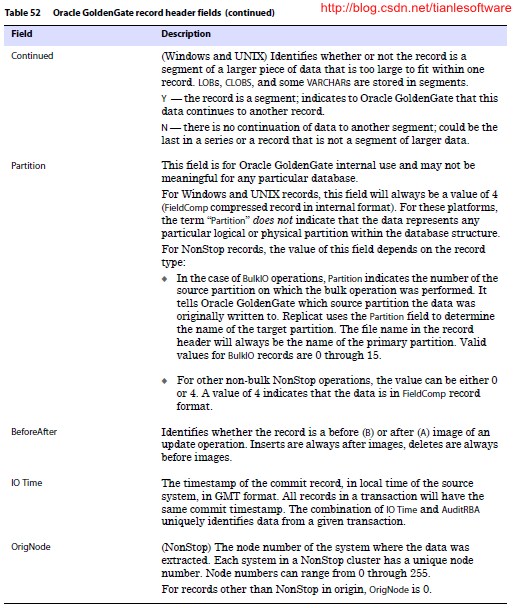
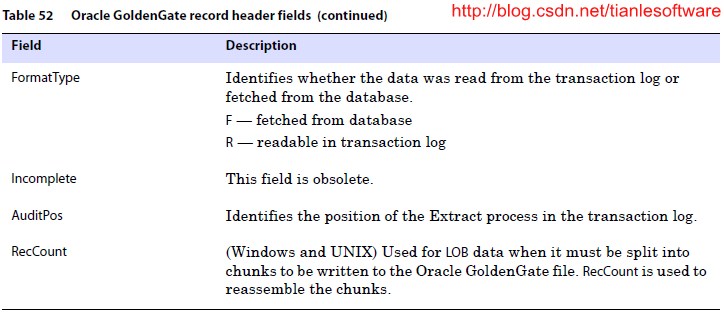
2.2.1.2 Using header data
Some of the dataavailable in the Oracle GoldenGate record header can be used for mapping byusing the GGHEADER option of the @GETENV function or by using any of the followingtransaction elements as the source expression in a COLMAP statement in the TABLEor MAP parameter.
(1)GGS_TRANS_TIMESTAMP
(2)GGS_TRANS_RBA
(3)GGS_OP_TYPE
(4)GGS_BEFORE_AFTER_IND
2.2.2 Record data area
The data area of the Oracle GoldenGatetrail record contains the following:
Trail 的data area 記錄瞭如下內容:
(1)The time that the change waswritten to the Oracle GoldenGate file
(2)The type of database operation
(3)The length of the record
(4)The relative byte addresswithin the trail file
(5)The table name
(6)The data changes in hex format
The followingexplains the differences in record image formats used by Oracle GoldenGate onWindows, UNIX, Linux, and NonStop systems. The terms “full” and “compressed”image format are used in the descriptions. These terms are used in a differentcontext here than when they are used in other parts of the documentation inreference to how Extract writes column data to the trail, meaning whether onlythe key and changed columns are written (“compressed”) versus whether allcolumns are written to the trail (“uncompressed” or “full image”).
2.2.2.1 Full record image format
Full record imageformat is only generated in the trail when the source system is HP NonStop, andonly when the IOType specified in the record header is one of the following:
--Full record image 格式僅在source system 是HPNonStop,並且在IOTye 指定如下型別時生成:
3 — Delete
5 — Insert
10 — Update
Each full recordimage has the same format as if retrieved from a program reading the originalfile or table directly. For SQL tables, datetime fields, nulls, and other datais written exactly as a program would select it into an application buffer.Although datetime fields are represented internally as an eight-byte timestamp,their external form can be up to 26 bytes expressed as a string. Enscriberecords are retrieved as they exist in the original file.
When theoperation type is Insert or Update, the image contains the contents of therecord after the operation (the after image). When the operation type is Delete,the image contains the contents of the record before the operation (the beforeimage).
--如果是insert 或 update 操作,那麼image包含的是after image,即修改之後的data,如果是delete,則儲存的beforeimage。
For recordsgenerated from an Enscribe database, full record images are output unless the originalfile has the AUDITCOMPRESS attribute set to ON. When AUDITCOMPRESS is ON, compressedupdate records are generated whenever the original file receives an update operation.(A full image can be retrieved by the Extract process by using the FETCHCOMPS parameter.)
2.2.2.2 Compressed record format
By default,trail records written by processes on Windows and UNIX systems are always compressed.The format of a compressed record is as follows:
<columnindex><column length><column data>[...]
--預設情況下,trail record是compress的,為什麼要compress在下一節說明。
Where:
(1)<column index> is the ordinal index ofthe column within the source table (2 bytes).
(2)<column length> is thelength of the data (2 bytes).
(3)<column data> is thedata, including NULL or VARCHAR length indicators.
Enscribe recordswritten from the NonStop platform may be compressed. The format of a compressedEnscribe record is as follows:
<fieldoffset><field length><field value>[...]
Where:
(1)<field offset> is the offset within theoriginal record of the changed value (2 bytes).
(2)<field length> is thelength of the data (2 bytes).
(3)<field data> is the data,including NULL or VARCHAR length indicators.
The first fieldin a compressed Enscribe record is the primary or system key.
2.2.2.3 Tokens area
The trail recordalso can contain two areas for tokens. One is for internal use and is not documentedhere, and the other is the user tokens area. User tokens are environment valuesthat are captured and stored in the trail record for replication to targetcolumns or other purposes. If used, these tokens follow the data portion of therecord and appear similar to the following when viewed with Logdump:
--trail record 的token 包含2個areas,其中一個供內部使用,文件就不做說明,另一個是user token。
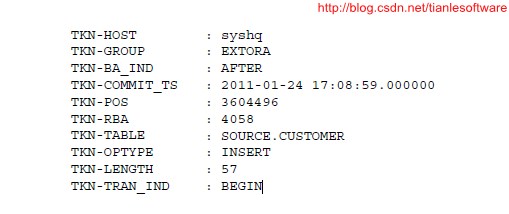
2.2.2.4 Oracle GoldenGate operation types
The followingare some of the Oracle GoldenGate operation types. Types may be added as newfunctionality is added to Oracle GoldenGate. For a more updated list, use the SHOWRECTYPE command in the Logdump utility.
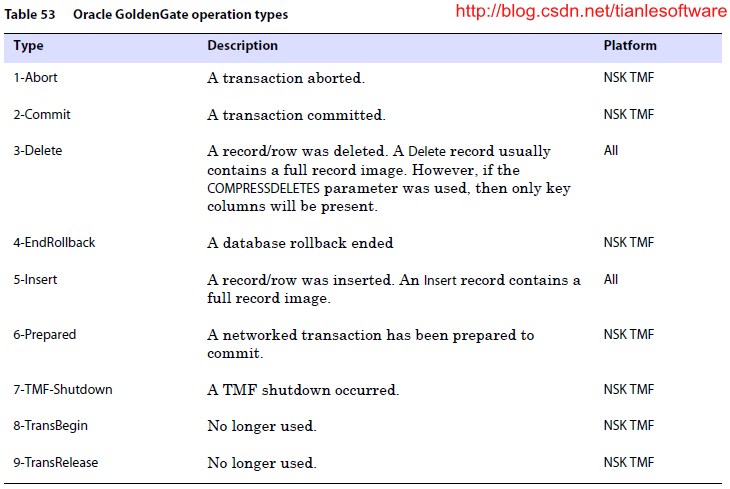
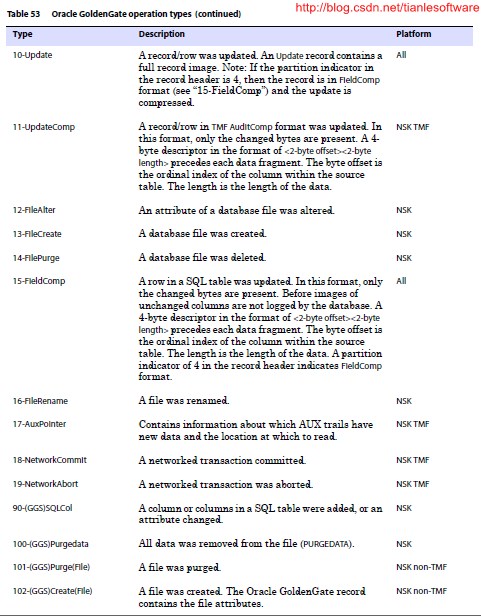
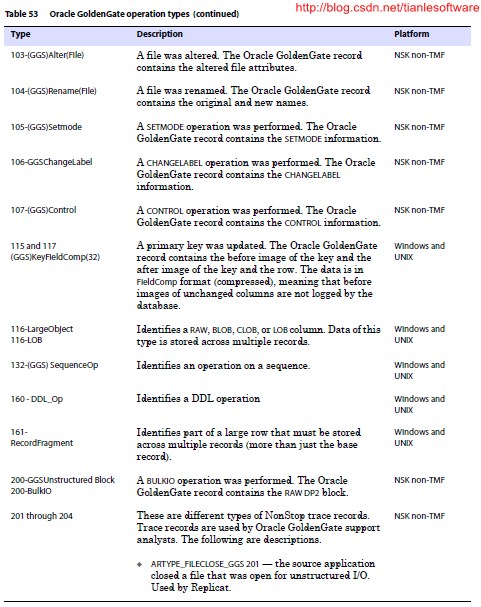
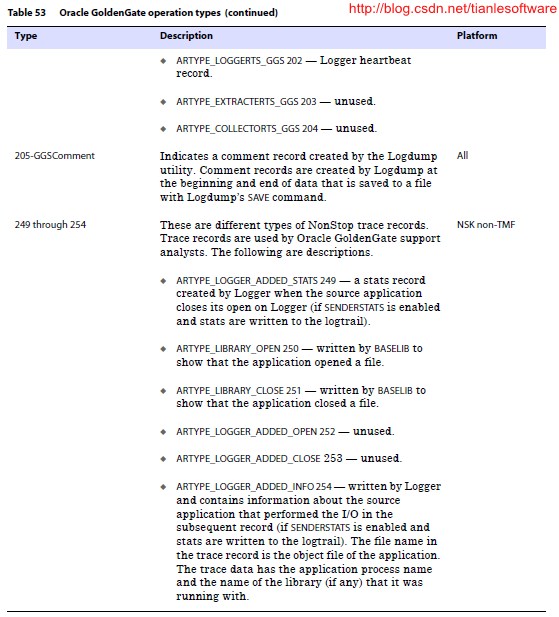
2.2.3 Oracle GoldenGate trail header record
In addition tothe transaction-related records that are in the Oracle GoldenGate trail, each trailfile contains a file header.
--在每個trail file中除了之前講的trail header,trailarea,還有一個file header。
The file headeris stored as a record at the beginning of a trail file preceding the data records.The information that is stored in the trail header provides enough information aboutthe records to enable an Oracle GoldenGate process to determine whether the recordsare in a format that the current version of Oracle GoldenGate supports.
The trail headerfields are stored as tokens, where the token format remains the same across allversions of Oracle GoldenGate. If a version of Oracle GoldenGate does not supportany given token, that token is ignored. Depracated tokens are assigned a defaultvalue to preserve compatibility with previous versions of Oracle GoldenGate.
You can view thetrail header with the FILEHEADER command in the Logdump utility.
三.trail再壓縮
在上面一節看到,預設情況下,trails 是compress的。當資料進行異地傳輸時,網路負載是影響資料傳輸效率的關鍵因素。GoldenGate的其中一個優勢是,它極大地壓縮了傳輸的trail檔案。
在預設壓縮(redo=>trail)的基礎上,GoldenGate提供了再壓縮方案:在傳輸trail之前對其進行進一步的壓縮,然後在寫入遠端trail之前再進行解壓。官方文件中說明這次再壓縮的壓縮比至少在4:1,實際中壓縮比率會更高,有網友測試達10:1。
這裡注意GoldenGate的再壓縮過程,壓縮之後傳送到Target 端後,在寫入遠端trail前又解壓了回來,所以單純比較兩端的trail檔案大小沒有變化。但是在傳輸過程中確實是壓縮了。
這樣的設計,可以減少對Replicat程序提取trail的影響,從而也避免了加重原本負載就相對較大的Replicat程序。
GoldenGate的再壓縮,是在負責向遠端傳送trail的Extract程序中配置的,因此一般情況下都是配置在datapump中。配置很簡單,在RMTHOST引數中加入COMPRESS子引數,如下:
GGSCI (gg1) 42> view params dpump
extract dpump
userid [email protected], password ggate
rmthost gg2, mgrport7809,compress,compressthreshold 0
rmttrail /u01/ggate/dirdat/lt
passthru
table dave.pdba;
-- COMPRESS啟用再壓縮,COMPRESSTHRESHOLD表示對大於該值的trail記錄塊進行壓縮,取值0到28000,預設1000,設定為0表示全部進行壓縮
啟用了壓縮後,會消耗額外的CPU,在同步事務量較大的情況下,需要考慮CPU負載。但實際上在大部分的GoldenGate應用場景中,網路負載都遠遠大於CPU負載,啟用trail再壓縮的可能性還是很大的。
-------------------------------------------------------------------------------------------------------
版權所有,文章允許轉載,但必須以連結方式註明源地址,否則追究法律責任!
Blog: http://blog.csdn.net/tianlesoftware
Weibo: http://weibo.com/tianlesoftware
Skype: tianlesoftware
-------加群需要在備註說明Oracle表空間和資料檔案的關係,否則拒絕申請----
DBA1 群:62697716(滿); DBA2 群:62697977(滿)DBA3 群:62697850(滿)
DBA 超級群:63306533(滿); DBA4 群:83829929(滿) DBA5群: 142216823(滿)
DBA6 群:158654907(滿) DBA7 群:69087192(滿)DBA8 群:172855474
DBA 超級群2:151508914 DBA9群:102954821 聊天 群:40132017(滿)
相關推薦
Oracle Golden Gate 系列十五 -- GG Trails 說明
一.Trails 說明 理論知識在系列一里有說明,這裡在拿出來看一下: To support thecontinuous extraction and replication of database changes, Oracle GoldenGatestores the captured chan
Oracle Golden Gate 系列十八 -- GG 多對一 real-time data warehousing 說明 與 示例
一.官網說明 A datawarehousing configuration is a many-to-one configuration. Multiple sourcedatabases send data to one target warehouse databas
Oracle Golden Gate 系列十六 -- 配置 GG 安全 說明 與 示例
由於GoldenGate所需的使用者許可權較大,而每個GoldenGate程序配置檔案中都需要設定該使用者和密碼用於資料庫登陸,出於安全性的考慮,建議將密碼進行加密。 官方文件上介紹的加密有如下三種方法: 1.Encryption Options are available for encrypting
Oracle Golden Gate 系列四 -- GG 安裝 與 解除安裝 理論知識
在前面的幾篇裡講了GG的系統需求及支援的物件型別, 在這裡看下GG的安裝與解除安裝的理論知識,這裡只介紹Linux 平臺的說明,其他平臺的自己參看官方文件。 一.GG 安裝說明 To install Oracle GoldenGate , the following s
Java設計模式菜鳥系列(十五)建造者模式建模與實現
郵箱 system for face tom 建造者模式 data mar 方法 轉載請註明出處:http://blog.csdn.net/lhy_ycu/article/details/39863125 建造者模式(Builder):工廠類模式提供的
ORACLE GOLDEN GATE oracle同步數據至kafka
文件夾 lin ebe inux display off wms alter common 一.服務器信息 ip 軟件版本 ogg版本 軟件包 操作系統版本 OGG安裝路徑 10.1.50.52 源 oracle11.2.0.4 12.2.0.1.1 V100
WPF入門教程系列十五——WPF中的數據綁定(一)
不同 pan cnblogs 雙向 one tap copy msd tac 使用Windows Presentation Foundation (WPF) 可以很方便的設計出強大的用戶界面,同時 WPF提供了數據綁定功能。WPF的數據綁定跟Winform與ASP.NET
轉://Oracle Golden Gate 概念和原理
拓撲 根據 target 提高 支持斷點續傳 占用 均衡負載 col 都是 引言:Oracle Golden Gate是Oracle旗下一款支持異構平臺之間高級復制技術,是Oracle力推一種HA高可用產品,簡稱“OGG”,可以實現Active-Active 雙業務中心架構
Hulu機器學習問題與解答系列 | 十五:多層感知機與布爾函數
功能 目標 機器學習 分享圖片 研究 vue gic per 發展 今天沒有別的話,好好學習,多多轉發! 本期內容是 【多層感知機與布爾函數】 場景描述 神經網絡概念的誕生很大程度上受到了神經科學的啟發。生物學研究表明,大腦皮層的感知與計算功能是通過分多層實現的
Oracle Golden Gate - 概念和機制
ogg Oracle Golden Gate ogg機制 ogg概念 Oracle Golden Gate - 概念和機制 (ogg)Golden Gate(簡稱OGG)提供異構環境下交易數據的實時捕捉、變換、投遞。 OGG支持的異構環境有: OGG的特性:對生產系統影響小:實時讀取交易日誌,
katalon系列十五:給瀏覽器新增cookie自動登陸
import org.openqa.selenium.Cookieimport org.openqa.selenium.WebDriverimport com.kms.katalon.core.webui.driver.DriverFactory WebUI.openBrowser('')
Linux系列十五-SELinux
一、執行說明 主體:類似等同於程序 目標:一般是檔案系統 策略: 1. targeted:針對網路服務限制較多,預設 2. strict:完整的SELinux限制 安全上下文:主體能不能訪問目標除了策略指定外,主體與目標的安全上下文必須一致才能
Docker系列(十五):Openshift 簡介
1.簡單瞭解openshift相關元件 1.openshift是基於容器技術構建的一個雲平臺 2.kubernetes是容器編排元件 3.docker是容器引擎驅動元件 4.openshift在Pass服務層預設提供了豐富的開發語言,開發框架,資料庫及中介軟體 2.
springboot系列十五、springboot整合PageHelper
一、介紹 專案中經常會遇到分頁,PageHelper為我們解決了這個問題。本質上實現了Mybatis的攔截器,作了分頁處理。 二、配置PageHelper 1、引入依賴 pagehelper-spring-boot-starter對了pagehelper做了封裝,減少 了配置檔案,只需要在yml新增就
MySQL---資料庫從入門走向大神系列(十五)-Apache的DBUtils框架使用
DBUtils簡介: commons-dbutils 是 Apache 組織提供的一個開源 JDBC工具類庫,它是對JDBC的簡單封裝,學習成本極低,並且使用dbutils能極大簡化jdbc編碼的工作量,同時也不會影響程式的效能。因此dbutils成為很多不喜
PyTorch學習系列(十五)——如何載入預訓練模型?
PyTorch提供的預訓練模型 PyTorch定義了幾個常用模型,並且提供了預訓練版本: AlexNet: AlexNet variant from the “One weird trick” paper. VGG: VGG-11, VGG-13, VGG
【玩轉資料系列十五】機器學習PAI為你自動寫歌詞,媽媽再也不用擔心我的freestyle了(提供資料、程式碼)
摘要: 背景 最近網際網路上出現一個熱詞就是“freestyle”,源於一個比拼rap的綜藝節目。在節目中需要大量考驗選手的freestyle能力,freestyle指的是rapper即興的根據一段主題講一串rap。 背景 最近網際網路上出現一個熱詞就是“freest
【深入淺出Node.js系列十五】Nodejs實現websocket的4種方式
WebSocket是HTML5開始提供的一種瀏覽器與伺服器間進行全雙工通訊的網路技術。在WebSocket API中,瀏覽器和伺服器只需要要做一個握手(handshaking)的動作,然後,瀏覽器和伺服器之間就形成了一條快速通道。兩者之間就直接可以資料互相傳送。 Web
hibernate系列十五:hql連線查詢,查詢效能優化,hql批量增刪改
一 hql連線查詢 和SQL查詢一樣,HQL也支援各種各樣的連線查詢,如內連線、外連線。我們知道在SQL中可通過join子句實現多表之間的連線查詢。HQL同樣提供了連線查詢機制,還允許顯式指定迫切內連線和迫切左外連線。HQL提供的連線方式如表1所示。 連線型別 HQL語法
Oracle Golden Gate體系架構詳解
GoldenGate簡介 Oracle Golden Gate軟體是一種基於日誌的結構化資料複製備份軟體,它通過解析源資料庫線上日誌或歸檔日誌獲得資料的增量變化,再將這些變化應用到目標資料庫,從而實現源資料庫與目標資料庫同步。Oracle Golden Gate可以在異
